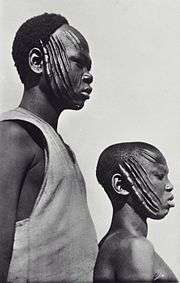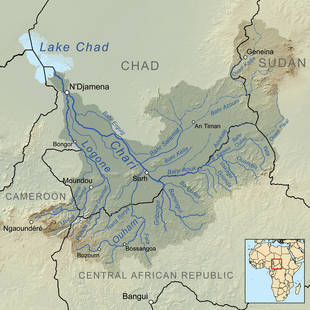Sara people
 A Sara woman | |
| Total population | |
|---|---|
| ~4 million | |
| Regions with significant populations | |
| The Republic of Chad, the Central African Republic, and the Republic of North Sudan | |
| Languages | |
| Sara languages, French | |
| Religion | |
| Christianity, Sara animism (traditional African religion), Islam | |
| Related ethnic groups | |
| Nilotic peoples |
The Sara people are Nilotes originating from the Upper Nile. They predominantly reside in southern Chad, the northwestern areas of the Central African Republic, and the southern border of North Sudan.[1] They speak the Sara languages, a dialect or sub-group of the Nilo-Saharan family.[2] They are also the largest ethnic group in Chad.[3][4]
Little is published about the Sara's history, society, or culture, due to the effects of colonialism, and tribalism. However, many historians have proved that they indeed migrated from the Upper Nile. During the colonial, and post-colonial period, historians outlined three theories regarding the origins of the Sara. One characterized them as the descendants of the Hyksos who conquered Ancient Egypt. Another, and the most plausible theory, claims they migrated from the Upper Nile into Central Africa in several waves, prompted by pressure from Islamic groups. The third theory claims the Sara were immigrants from the Middle East (i.e. Assyria).
Sara oral histories add further details about the people. In summary, the Sara are mostly animists (veneration of nature), with a social order made up of several patrilineal clans formerly united into a single polity with a national language, national identity, and national religion. Many Sara people have retained their ethnic religion, but some have converted to Christianity and Islam.[5]
Overview
In Chad
The Sara (Kameeni) are the largest ethnic group in the Republic of Chad, they're concentrated in the Moyen-Chari, the Logone Oriental, the Logone Occidental, and parts of the Tandjile regions. They're originally from the Nile valley and migrated towards what is now Chad during the sixteenth century AD, seeking refuge in the south against northern Muslim slave raiders.[6] After their arrival, they continued to be the target of violent raids by northern Fulani and Arab people.[5][7][8]

The local Muslim groups of what is now Chad, referred to the Sara as "Kirdi", with the term "Kirdi" denoting a non-Muslim person. The Muslim raiders of what is now Chad were autonomously called "Bagirmi", and this geo-political conflict between the Kirdi and the Bagirmi continued through the nineteenth century.[10][11]
The French colonial empire entered the ongoing hostilities in the early twentieth century, and the Sara people became a part of the French Equatorial Africa, more specifically as part of the "1e Tchad utile". The Sara society was transformed by this development, both in terms of culture such as French-based education and training, but also socio-economically because of forced labor and conscription to serve the French military during the World Wars.[10] At the time of independence from France in 1960, the southerners of Chad were more assimilated into French institutions than the northerners.[10] This led to their political dominance of the country after 1960. They were also a part of the civil war with populations in north and central Chad, each population aligning with a different ideology.[11]
In the Central African Republic
The Sara people make up ten per cent of the population of the Central African Republic, making it the fourth largest ethnic group in the country. They live in the northwest part of CAR.
Languages
The Sara people natively speak the Sara languages. This dialect cluster belongs to the Nilo-Saharan family.
Genetics
Analysis of classic genetic markers and DNA polymorphisms by Excoffier et al. (1987) found that the Sara are most closely related to the Kunama people of Eritrea. Both populations speak languages from the Nilo-Saharan family. They are also similar to West African populations, but biologically distinct from the surrounding Cushitic and Ethiopian Semitic Afro-Asiatic-speaking groups.[12]
Famous Sara people
- François Tombalbaye, first President of Chad
- Noël Milarew Odingar, who overthrew Tombalbaye during the 1975 coup
- Fidèle Moungar, Prime minister of Chad in 1993, president of Action for Unity and Socialism
- Sosthene Moguenara, Chad born German Track and Field Athlete
See also
References
- ↑ Sara people, Encyclopædia Britannica
- ↑ Sara languages, Ethnologue
- ↑ Chad: Society and People, CIA Factbook, US Government
- ↑ Christine Zuchora-Walske (2009). Chad in Pictures. Twenty-First Century. p. 47. ISBN 978-1-57505-956-3.
- 1 2 3 James Stuart Olson (1996). The Peoples of Africa: An Ethnohistorical Dictionary. Greenwood. p. 510. ISBN 978-0-313-27918-8.
- ↑ http://www.our-africa.org/chad/history-politics
- ↑ M. J. Azevedo (2005). The Roots of Violence: A History of War in Chad. Routledge. pp. 10–11. ISBN 978-1-135-30080-7.
- ↑ Kevin Shillington (2013). Encyclopedia of African History 3-Volume Set. Routledge. p. 228. ISBN 978-1-135-45670-2.
- ↑ Mario Zamora et al (1981), Image and Reality in African Interethnic Relations: The Fulbe and their Neighbors, US Department of Education, pages 136-137, 162-167
- 1 2 3 David Levinson (1996). "Sara". The Encyclopedia of World Cultures - 10 Volume set, 1st Edition. Gale. ISBN 978-0816118403.
- 1 2 Anthony Appiah; Henry Louis Gates (2010). Encyclopedia of Africa. Oxford University Press. pp. 253–256. ISBN 978-0-19-533770-9.
- ↑ Excoffier, Laurent et al. (1987). "Genetics and history of sub-Saharan Africa". American Journal of Physical Anthropology. 30: 151–194. doi:10.1002/ajpa.1330300510. Retrieved 1 September 2016.
Bibliography
- René Lemarchand, The Politics of Sara Ethnicity: A Note on the Origins of the Civil War in Chad, in: Cahiers d'Études africaines, Vol. 20, Cahier 80 (1980)
- René Lemarchand, Chad: The Misadventures of the North-South Dialectic, in: African Studies Review, Vol. 29, No. 3 (Sept., 1986)
- Mario Azevedo, The Human Price of Development: The Brazzaville Railroad and the Sara of Chad, in: African Studies Review, Vol. 24, No. 1 (Mar., 1981)
- Mario Azevedo, Power and Slavery in Central Africa: Chad (1890-1925), in: The Journal of Negro History, Vol. 67, No. 3 (Autumn, 1982)
- Robert Jaulin, La Mort Sara, Paris, 10/18, 1971 (1967)
